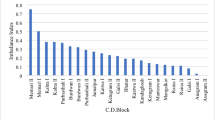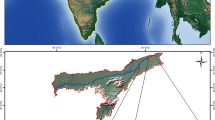Abstract
The study is concerned with the acidity of degraded agricultural soils. The main objective of the research is the actual and potential soil acidity of agricultural lands of the Donetsk People’s Republic on the example of agricultural farms in the northern part of the Shakhtyorskii district. It was found that the studied model sites are characterized by a slightly acidic, neutral, or slightly alkaline medium reaction, which creates favorable conditions for the formation of crops and plant growth. Investigation of exchangeable acidity of soils revealed the ambiguity of changes in its values, depending on the location of the model sites, system of soil management in the crop rotation, horizon, and other factors. The highest excess of the exchange acidity over the control values is characteristic of the slope surfaces of sites, on which the intensity of erosion processes reaches a maximum (exceeding the indicator by 8.6% on average compared to the control). In the future, increased values of exchangeable acidity may adversely affect the formation of crop yields. Changes in the values of hydrolytic acidity of soils follow the same pattern as the variation in the indices of exchangeable acidity. The most significant excess of the hydrolytic acidity index in comparison with the control was recorded on the sloping sites of the fields (increase by 11–17%). The conducted studies confirm the need for constant agroecological monitoring of these lands with regulation of the application of mineral fertilizers to increase the absorption capacity of soils due to increased values of exchangeable and hydrolytic acidity.
Similar content being viewed by others
REFERENCES
Agrokhimiya (Agrochemistry), Smirnov, P.M. and Muravin, E.A., Eds., Moscow: Kolos, 1984.
Arinushkina, E.V., Rukovodstvo po khimicheskomu analizu pochv (Chemical Analysis for Soils: Handbook), Moscow: MSU, 1970.
Assessment of soil biodiversity policy instruments in EU-27, Final Report, European Commission DG ENV. Bio Intelligence Service, Feb. 2010.
Azizov, Z.M., The acidity of southern chernozem and the yield of winter wheat under different methods of basic tillage and fertilizers in crop rotation, Usp. Sovr. Estestvozn., 2018, no. 2, pp. 35–42.
Dospekhov, B.A., Metodika polevogo opyta (s osnovami statisticheskoi obrabotki rezul’tatov issledovanii) (Field Experience Methodology (with the Basics of Statistical Processing of Research Results)), Moscow: Agropromizdat, 1985.
Grigor’yan, B.R., Kol’tsova, T.G., and Sungatullina, L.M., Metodicheskie rekomendatsii po otsenke pochvenno-ekologicheskogo sostoyaniya zemel’ sel’khoznaznacheniya na sootvetstvie trebovaniyam organicheskogo zemledeliya (Guidelines for Assessing the Soil-Ecological State of Agricultural Land for Compliance for meeting the Requirements of Organic Farming), Kazan, 2014.
Kozlov, A.V. and Uromova, I.P., The way to estimate podzolized chernozem agroecological state for the ecosystem of the southern part of Nizhny Novgorod Region, Usp. Sovr. Estestvozn., 2018, no. 12, pp. 63–69.
Kulikov, Ya.K., Pochvennye resursy: uchebnoe posobie (Soil Resources. Student’s Book), Minsk: Vysshaya Shkola, 2012.
Lukin, S.V. and Prazina, E.A., Monitoring of soil acidity in the Central Chernozem region of Russia, Dostizh. Nauki Tekh. Agroprom. Kompleksa, 2019, vol. 33, no. 4. https://doi.org/10.24411/0235-2451-2019-10402
Metody pochvennoi mikrobiologii i biokhimii (Methods of Soil Microbiology and Biochemistry), Zvyagintsev, D.G., Ed., Moscow: MSU, 1991.
Praktikum po agrokhimii (Workshop on Agricultural Chemistry), Mineev, V.G., Ed., Moscow: MSU, 2001.
Priseds’kii, Yu.G., Statistichna obrobka rezul’atov biologichnikh eksperimentov: navchal’nii posibnik (Statistical Processing of Biological Experiments: Student’s Book), Donetsk: Cassiopeia, 1999.
Rozanov, B.G., Morfologiya pochv (Soil’s Morphology), Moscow: MSU, 1983.
Shul’gina, E.A. and Popov, S.S., Changes in the actual and exchange acidity of soils in the Arctic, in Nauka segodnya: vyzovy, perspektivy i vozmozhnosti: Materialy mezhdunarodnoi nauchno-prakticheskoi konferentsii. V 2-kh chastyakh (Proc. Int. Sci.-Pract. Conf. Science Today: Challenges, Prospects and Opportunities. In 2 Parts), Vologda: Marker LLC, 2019, pp. 8–12.
Zakharova, I.A., Acidity change for Chelyabinsk Region chernozems, Agroprom. Kompleks Ross., 2017, vol. 24, no. 4, pp. 940–943.
Funding
This work was supported as a part of the state-funded research topic “Qualitative and Functional Characteristics of Soils of Agricultural Lands in the Steppe Zone and Pathways to Recovery of Their Biological Productivity.”
Author information
Authors and Affiliations
Corresponding author
Ethics declarations
The authors declare that they have no conflicts of interest.
Additional information
Translated by E. Kuznetsova
About this article
Cite this article
Agurova, I.V., Syshchykov, D.V. Acidity of Degraded Soils of Agricultural Lands in the Donetsk People’s Republic. Moscow Univ. Soil Sci. Bull. 78, 301–306 (2023). https://doi.org/10.3103/S014768742303002X
Received:
Revised:
Accepted:
Published:
Issue Date:
DOI: https://doi.org/10.3103/S014768742303002X




